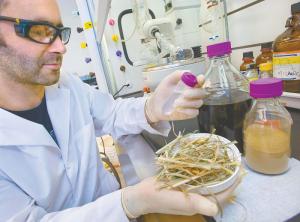“One Pot Process” Simplifies Cellulosic Biofuel Production
 ✖  |
Government researchers have demonstrated a new “one-pot” process for making biofuels out of cellulose. It is cheaper, easier and more versatile than existing processes. They used an ionic liquid (a salt solvent that is liquid at room temperature) to break down the plant material for microbes to ferment.
“We’ve been working on it for 9 years and now have a process that is cost competitive, can be scaled up, and can be varied to produce a variety of biofuels and chemicals,” says Blake Simmons, chief science and technology officer, Joint BioEnergy Institute (JBEI). JBEI researchers are from the Department of Energy’s Lawrence Berkeley National Laboratory and Sandia National Laboratories.
Simmons says the JBEI process simplifies the conversion of lignin biomass into a fuel. Instead of multiple steps with pretreatments, hydrolization, and fermentation to produce a biofuel, it does everything in a single “pot” in one step. Feedstock and process components, including the ionic liquid and microbes, are added to the pot during the process. The ionic liquid breaks down the cellulose into basic sugars. The microbes then convert the sugars into the final product. When the process is finished, only the desired output fuel or chemical remains with no byproducts. Even the ionic liquid can be captured and reused.
Simmons explains that success with the project came when they turned away from searching for a solvent that would produce the highest sugar yield. Too often the solvents were toxic to the microbes and required a complex system to overcome toxicity. Instead, the JBEI team looked for a solvent that was friendly to the biology and less complex. They also discovered that introducing carbon dioxide during the deconstruction phase neutralized the toxicity of ionic liquids.
“We not only lowered operating costs, but also the capital expense for a facility,” says Simmons. “Different outputs require different pathways, but the system remains the same.”
Existing biofuel plants are usually limited to one feedstock for one process and one product. The JBEI process works with grasses, hardwood, softwood and even biowaste.
“It could run on mixed streams or vary with the season,” says Simmons. “I think our approach will give a biorefiner more flexibility to use the feedstock that is most reasonable in cost at any time of the year.”
Simmons has relatives farming in Nebraska and realizes how important ethanol production has become. He suggests the process could be a “bolt-on” addition to existing ethanol plants. It could convert existing byproduct (dried distillers grains) as well as other biomass to fuel.
“Our job is to develop it to the point where someone else can build a turnkey system,” says Simmons.
Contact: FARM SHOW Followup, Joint BioEnergy Institute, 5885 Hollis St., Emeryville, Calif. 94608 (ph 510 495-2620; www.jbei.org).

Click here to download page story appeared in.
Click here to read entire issue
“One Pot Process” Simplifies Cellulosic Biofuel Production ENERGY Alternative Fuels Government researchers have demonstrated a new “one-pot” process for making biofuels out of cellulose It is cheaper easier and more versatile than existing processes They used an ionic liquid a salt solvent that is liquid at room temperature to break down the plant material for microbes to ferment “We’ve been working on it for 9 years and now have a process that is cost competitive can be scaled up and can be varied to produce a variety of biofuels and chemicals ” says Blake Simmons chief science and technology officer Joint BioEnergy Institute JBEI JBEI researchers are from the Department of Energy’s Lawrence Berkeley National Laboratory and Sandia National Laboratories Simmons says the JBEI process simplifies the conversion of lignin biomass into a fuel Instead of multiple steps with pretreatments hydrolization and fermentation to produce a biofuel it does everything in a single “pot” in one step Feedstock and process components including the ionic liquid and microbes are added to the pot during the process The ionic liquid breaks down the cellulose into basic sugars The microbes then convert the sugars into the final product When the process is finished only the desired output fuel or chemical remains with no byproducts Even the ionic liquid can be captured and reused Simmons explains that success with the project came when they turned away from searching for a solvent that would produce the highest sugar yield Too often the solvents were toxic to the microbes and required a complex system to overcome toxicity Instead the JBEI team looked for a solvent that was friendly to the biology and less complex They also discovered that introducing carbon dioxide during the deconstruction phase neutralized the toxicity of ionic liquids “We not only lowered operating costs but also the capital expense for a facility ” says Simmons “Different outputs require different pathways but the system remains the same ” Existing biofuel plants are usually limited to one feedstock for one process and one product The JBEI process works with grasses hardwood softwood and even biowaste “It could run on mixed streams or vary with the season ” says Simmons “I think our approach will give a biorefiner more flexibility to use the feedstock that is most reasonable in cost at any time of the year ” Simmons has relatives farming in Nebraska and realizes how important ethanol production has become He suggests the process could be a “bolt-on” addition to existing ethanol plants It could convert existing byproduct dried distillers grains as well as other biomass to fuel “Our job is to develop it to the point where someone else can build a turnkey system ” says Simmons Contact: FARM SHOW Followup Joint BioEnergy Institute 5885 Hollis St Emeryville Calif 94608 ph 510 495-2620; www jbei org
To read the rest of this story, download this issue below or click
here to register with your account number.







